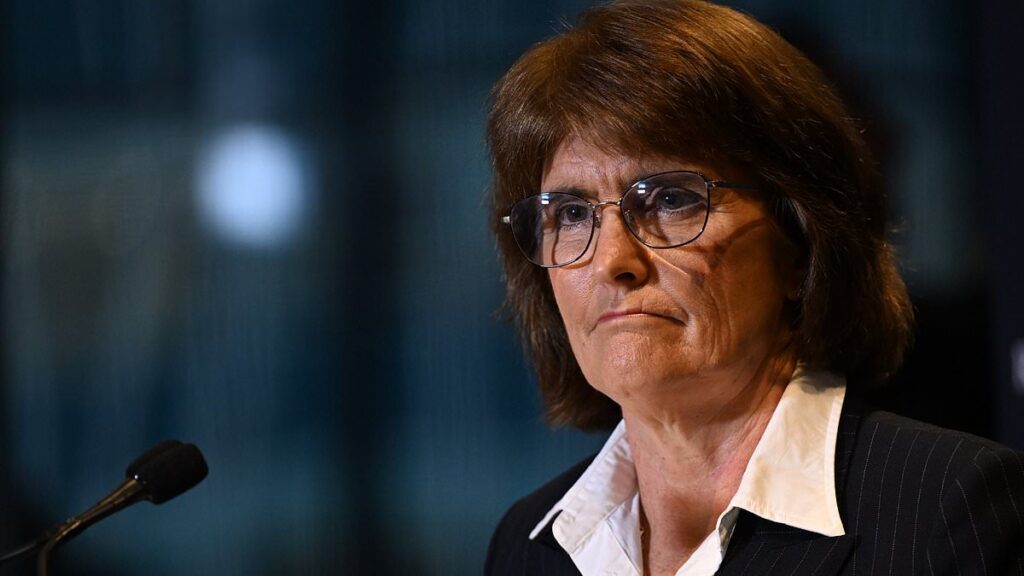Australian home borrowers could look forward to a super-sized interest rate cut as the Reserve Bank admits it has examined slashing rates by 50 basis points.
The Reserve Bank on Tuesday reduced interest rates by 25 basis points, taking the cash rate back to 3.85 per cent for the first time since June 2023.
This also marked the second lowering of interest rates for 2025, with inflation now back within the RBA’s two to three per cent target for the first time in four years.
In a sign the RBA will soon deliver a much larger cut, Reserve Bank Governor Michele Bullock said a bigger 50 basis point cut was considered on Tuesday – this would have saved an average borrower $200 on monthly repayments.
‘First of all, it was a consensus decision. What the board discussed was two options: hold or lower,’ she told reporters in Sydney.
‘There was a bit of a discussion about hold and that was, sort of, put aside pretty quickly. (Then) the discussion then was about a cut and how big (it would be). There was a discussion about 50 and 25.’
Borrowers haven’t had a 50 basis point rate cut since May 2012, following the end of the mining boom. The RBA eased rates by smaller amounts during Covid in 2020.
The RBA’s latest rate cut will see standard variable home loan rates among the Big Four banks fall under six per cent.
Australian home borrowers can looking forward to a super-sized interest rate cut with the Reserve Bank alert to the possibility of a recession
Another 50 basis point rate cut at the Reserve Bank’s next meeting in July, once combined with Tuesday’s relief, would save a borrower with an average $660,000 mortgage another $209 on their monthly repayments.
It would see the cash rate fall to 3.35 per cent for the first time since March 2023, and see online-only mortgage rate fall close to the 5 per cent level.
But Ms Bullock also had some not so welcome news for Aussies.
She said the RBA monetary policy board was worried about the prospect of a recession in the next two years, as Donald Trump’s tariffs hurt global growth and caused Australia’s economy to shrink for two consecutive quarters.
‘If you look at our scenario analysis, it does suggest that in a really bad outcome, there could possibly be a recession, yes, but that’s in the very extreme circumstance,’ she said.
‘At the moment, we’re not looking at that, we need to be alert.’
Australia’s last recession was in 2020 during the Covid lockdowns but a rate rise-induced recession hasn’t occurred since 1991.
Reserve Bank Governor Michele Bullock said a bigger 50 basis point cut was considered on Tuesday, which would have saved an average borrower $200 on monthly repayments
The Reserve Bank is expecting sluggish economic growth to continue until at least mid-2027.
Australia’s economy was only expected to grow by 1.8 per cent during 2024-25,
The 2.2 per cent growth pace forecast for 2027 is still well below the long-run, three-decade average of 3 per cent.
The futures market is expecting the RBA cash rate to fall to 3.1 per cent by the end of 2025, for the first time since February 2023, which would imply another 75 basis points of relief from the Reserve Bank.
More rate cuts are likely to see another boom in house prices, with immigration still at high levels.
But Ms Bullock said the effect of rate cuts on house prices wasn’t her chief concern, even though it will lock more young people out of the housing market.
‘I understand that people are really concerned about housing prices,’ she said.
‘Our focus has to be on inflation and if the right thing to do in terms of employment and inflation is to lower interest rates, I think we have to accept what that might imply for housing prices.
‘If we start thinking about ”Well, do we lower interest rates because of housing prices?” (then) we’re going to take our eye off the ball – which is inflation and employment – and I don’t think that would be the right thing to do.’
The RBA chief said housing supply wasn’t her key responsibility.
‘So, I acknowledge some people are worried that as interest rates come down, housing prices will rise, but other policies have really got to step up here and address what is a housing shortage.’

